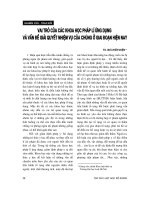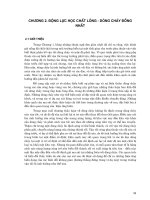Slide khóa học pháp lý chương 2 understanding computer investigations
Bạn đang xem bản rút gọn của tài liệu. Xem và tải ngay bản đầy đủ của tài liệu tại đây (1.4 MB, 56 trang )
.c
om
du
o
ng
th
an
co
ng
Guide to Computer Forensics
and Investigations
Fourth Edition
cu
u
Chapter 2
Understanding Computer
Investigations
CuuDuongThanCong.com
/>
.c
om
Objectives
cu
u
du
o
ng
th
an
co
ng
• Explain how to prepare a computer investigation
• Apply a systematic approach to an investigation
• Describe procedures for corporate high-tech
investigations
• Explain requirements for data recovery
workstations and software
• Describe how to conduct an investigation
• Explain how to complete and critique a case
CuuDuongThanCong.com
/>
.c
om
ng
co
cu
u
du
o
ng
th
an
Preparing a Computer
Investigation
CuuDuongThanCong.com
/>
.c
om
Preparing a Computer Investigation
ng
th
an
co
ng
• Role of computer forensics professional is to gather
evidence to prove that a suspect committed a
crime or violated a company policy
• Collect evidence that can be offered in court or at a
corporate inquiry
cu
u
du
o
– Investigate the suspect’s computer
– Preserve the evidence on a different computer
CuuDuongThanCong.com
/>
.c
om
Preparing a Computer Investigation
(continued)
co
ng
• Follow an accepted procedure to prepare a case
• Chain of custody
cu
u
du
o
ng
th
an
– Route the evidence takes from the time you find it
until the case is closed or goes to court
CuuDuongThanCong.com
/>
.c
om
An Overview of a Computer Crime
ng
• Computers can contain information that helps law
enforcement determine:
an
co
– Chain of events leading to a crime
– Evidence that can lead to a conviction
ng
th
• Law enforcement officers should follow proper
procedure when acquiring the evidence
u
du
o
– Digital evidence can be easily altered by an
overeager investigator
cu
• Information on hard disks might be password
protected
CuuDuongThanCong.com
/>
cu
u
du
o
ng
th
an
co
ng
.c
om
Examining a Computer Crime
CuuDuongThanCong.com
/>
.c
om
An Overview of a Company Policy
Violation
an
co
ng
• Employees misusing resources can cost
companies millions of dollars
• Misuse includes:
cu
u
du
o
ng
th
– Surfing the Internet
– Sending personal e-mails
– Using company computers for personal tasks
CuuDuongThanCong.com
/>
.c
om
ng
co
an
cu
u
du
o
ng
th
Taking a Systematic Approach
CuuDuongThanCong.com
/>
ng
• Steps for problem solving
.c
om
Taking a Systematic Approach
cu
u
du
o
ng
th
an
co
– Make an initial assessment about the type of case
you are investigating
– Determine a preliminary design or approach to the
case
– Create a detailed checklist
– Determine the resources you need
– Obtain and copy an evidence disk drive
CuuDuongThanCong.com
/>
.c
om
Taking a Systematic Approach
(continued)
u
du
o
ng
th
an
co
Identify the risks
Mitigate or minimize the risks
Test the design
Analyze and recover the digital evidence
Investigate the data you recover
Complete the case report
Critique the case
cu
–
–
–
–
–
–
–
ng
• Steps for problem solving (continued)
CuuDuongThanCong.com
/>
.c
om
Assessing the Case
co
an
u
du
o
ng
th
Situation
Nature of the case
Specifics of the case
Type of evidence
Operating system
Known disk format
Location of evidence
cu
–
–
–
–
–
–
–
ng
• Systematically outline the case details
CuuDuongThanCong.com
/>
.c
om
Assessing the Case (continued)
co
ng
• Based on case details, you can determine the case
requirements
cu
u
du
o
ng
th
an
– Type of evidence
– Computer forensics tools
– Special operating systems
CuuDuongThanCong.com
/>
.c
om
Planning Your Investigation
co
ng
• A basic investigation plan should include the
following activities:
cu
u
du
o
ng
th
an
– Acquire the evidence
– Complete an evidence form and establish a chain of
custody
– Transport the evidence to a computer forensics lab
– Secure evidence in an approved secure container
CuuDuongThanCong.com
/>
.c
om
Planning Your Investigation
(continued)
u
du
o
ng
th
an
co
Prepare a forensics workstation
Obtain the evidence from the secure container
Make a forensic copy of the evidence
Return the evidence to the secure container
Process the copied evidence with computer
forensics tools
cu
–
–
–
–
–
ng
• A basic investigation plan (continued):
CuuDuongThanCong.com
/>
.c
om
Planning Your Investigation
(continued)
th
an
co
ng
• An evidence custody form helps you document
what has been done with the original evidence and
its forensics copies
• Two types
ng
– Single-evidence form
du
o
• Lists each piece of evidence on a separate page
cu
u
– Multi-evidence form
CuuDuongThanCong.com
/>
cu
u
du
o
ng
th
an
co
ng
.c
om
Planning Your Investigation
(continued)
CuuDuongThanCong.com
/>
cu
u
du
o
ng
th
an
co
ng
.c
om
Planning Your Investigation
(continued)
CuuDuongThanCong.com
/>
.c
om
Securing Your Evidence
cu
u
du
o
ng
th
an
co
ng
• Use evidence bags to secure and catalog the
evidence
• Use computer safe products
– Antistatic bags
– Antistatic pads
• Use well padded containers
• Use evidence tape to seal all openings
– Floppy disk or CD drives
– Power supply electrical cord
CuuDuongThanCong.com
/>
.c
om
Securing Your Evidence (continued)
cu
u
du
o
ng
th
an
co
ng
• Write your initials on tape to prove that evidence
has not been tampered with
• Consider computer specific temperature and
humidity ranges
CuuDuongThanCong.com
/>
.c
om
ng
co
cu
u
du
o
ng
th
an
Procedures for Corporate
High-Tech Investigations
CuuDuongThanCong.com
/>
.c
om
Procedures for Corporate High-Tech
Investigations
ng
• Develop formal procedures and informal checklists
cu
u
du
o
ng
th
an
co
– To cover all issues important to high-tech
investigations
CuuDuongThanCong.com
/>
.c
om
Employee Termination Cases
an
co
ng
• Majority of investigative work for termination cases
involves employee abuse of corporate assets
• Internet abuse investigations
th
– To conduct an investigation you need:
u
du
o
ng
Organization’s Internet proxy server logs
Suspect computer’s IP address
Suspect computer’s disk drive
Your preferred computer forensics analysis tool
cu
•
•
•
•
CuuDuongThanCong.com
/>
.c
om
Employee Termination Cases
(continued)
• Internet abuse investigations (continued)
ng
– Recommended steps
cu
u
du
o
ng
th
an
co
• Use standard forensic analysis techniques and
procedures
• Use appropriate tools to extract all Web page URL
information
• Contact the network firewall administrator and request
a proxy server log
• Compare the data recovered from forensic analysis to
the proxy server log
• Continue analyzing the computer’s disk drive data
CuuDuongThanCong.com
/>
ng
• E-mail abuse investigations
.c
om
Employee Termination Cases
(continued)
co
– To conduct an investigation you need:
cu
u
du
o
ng
th
an
• An electronic copy of the offending e-mail that
contains message header data
• If available, e-mail server log records
• For e-mail systems that store users’ messages on a
central server, access to the server
• Access to the computer so that you can perform a
forensic analysis on it
• Your preferred computer forensics analysis tool
CuuDuongThanCong.com
/>









